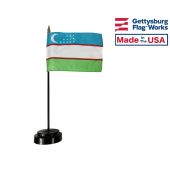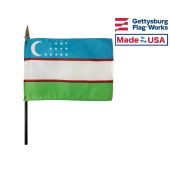Flag of Uzbekistan
Flag of Uzbekistan
Uzbekistan flags are strong symbols of the Uzbek people and their nation. The flag was selected from a variety of designs that were submitted by the Uzbek people after the nation gained its independence near the end of the 20th century. The government acted quickly, which gave Uzbekistan the honor of being the first of the newly-independent nation in Asia to select a flag following the fall of the Soviet Union.
The flag of Uzbekistan (Uzbek: Oʻzbekiston davlat bayrogʻi) was approved at the Seventh Extraordinary Session of the Supreme Council of the Republic of Uzbekistan, on November 18, 1991.
Symbolism according to the Uzbek embassy: The State flag of the Republic of Uzbekistan was approved at the Seventh Extraordinary Session of the Supreme Council of the Republic of Uzbekistan, on November, 18, 1991. The State flag and its symbols portray the historical links with states which have existed in the past within the borders of modern Uzbekistan and embodies in itself the national and cultural traditions of the republic.
- The color blue on the flag is a symbol of the eternal sky and life-giving water, which reflect the essence of life. In symbolic language it represents goodness, wisdom, honesty, glory and loyalty. Consequently, the color of Amir Temur’s state flag was also blue.
- The color white on the flag, symbolizing holy peace, harmonizes with the illumination of the day and the sources of light in the universe. The color white is a symbol of purity, transparency, innocence, the cleanliness of desires and dreams, and a striving for inner beauty.
- The color green is a symbol of the renewal of nature. In quite a few nations, it is considered to be a symbol of youth, hope and joy.
- The red stripes are tributaries of the power of life that flows in our bodies.
- The depiction of a youthful crescent moon is connected with our historical traditions. At the same time it is a symbol of the independence which we have obtained.
- Stars are considered a spiritual, divine symbol for all nations. The 12 stars depicted on the state flag of the Republic of Uzbekistan are also directly connected with our historical traditions, with the ancient calendar-cycle of the sun. Our attention to the 12 stars is also explained by the development of astronomy in the scientific thought of the ancient states within the borders of Uzbekistan. It is necessary to understand the depiction of 12 stars on our state flag as a symbol of the antiquity of the culture of the Uzbek people, its maturity and the striving for happiness in its land.
- Capital of Uzbekistan: Tashkent
- Area of Uzbekistan: 425,400 sq. km
- Languages used in Uzbekistan: Uzbek, Russian, Tajik
- Religions in Uzbekistan: Muslim, Eastern Orthodox
Colors and Symbolism of Uzbekistan Flags
Uzbekistan flags five horizontal stripes. The blue, white, and green stripes are significantly thicker than the two red stripes, which serves as a border around the white band. The flag's canton displays a white crescent moon and twelve white stars. The crescent moon is a symbol of Islam, which is the most commonly religion in Uzbekistan by a very large margin. The stars represent the months of the Islamic calendar and the constellations of the Zodiac.
Each color also has a symbolic meaning of its own. The blue band is a reference to the flag of Timur, who once ruled over a significant part of Asia. It is also a symbol of the sky and water. The white band is a symbol of peace and spiritual purity for the Uzbek people. The green stripe is a symbol of nature, although it is also often used on flags as a symbol of the Islamic faith. The red bands represent life as embodied by the blood that flows through living creatures.
History of Uzbekistan Flags
The modern flag of Uzbekistan drew inspiration from the flag that represented it during the Soviet era. That flag came into use to represent the Uzbek Soviet Socialist Republic in 1952, and it strongly resembled the flags of many other nations within the Soviet sphere of influence. It had a solid red field that was divided into two parts by a light blue stripe with a white border. It also had the crossed hammer and sickle below a star in the canton. The red field, hammer, sickle, and star were symbols of the Soviet Union, while the blue stripe represented the sky and the white border represented the nation's cotton industry.
That flag fell out of use when the Soviet Union fell, and Uzbekistan replaced it with the current design in 1991. The influence of the Soviet flag can still be seen in the modern flag's blue stripe, which was taken from the flag of the Soviet era.





